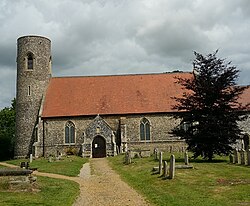Belton, Suffolk
| Belton | |
| Suffolk | |
|---|---|
 Belton's medieval church | |
| Location | |
| Grid reference: | TG483027 |
| Location: | 52°33’56"N, 1°39’46"E |
| Data | |
| Population: | 3,805 (2011 (parish)) |
| Post town: | Great Yarmouth |
| Postcode: | NR31 |
| Local Government | |
| Council: | Great Yarmouth |
Belton is a village in Suffolk, at the edge of the Suffolk Broads, between the final, tidal reach of the River Waveney which flows hallf a mile to the west of the village and Gorleston-on-Sea to the east, which adjoins into Great Yarmouth across the Waveney in Norfolk.
The Belton Marshes extend in a narrow band between the village and the Waveney. There was once a station here on the railway line to Yarmouth, but the line has been closed and lifted.
The village is counted with Browston in a civil parish with a population of 3,805 at the 2011 Census.
History
The earliest evidence of human inhabitation is a flint axehead from the Palaeolithic period. The fort at nearby Burgh Castle along with finds of coins and pottery indicate that the area was inhabited throughout the Roman period.
Belton is recorded in the Domesday Book of 1086 as Beletun.[1]
During the Middle Ages, Belton was essentially an agricultural community. There is no mention of a church in Belton at the time of Domesday Book. The earliest record of the church is in the time of Henry I who ruled from 1100-1135. Judging by architectural style, the current church building dates form the 1300s with major restoration work taking place from 1837 carried out at the direction of the Rev Revd Francis Howes and his family. The tower was rebuilt in 1849.
Belton was affected by the Great Plague of 1665. The parish register lists 13 burials with 7 listed as "plague". At the time, three or four burials a year was normal.
Belton continued as a small farming community until in 1858 the railway came, with the opening of Belton Station, giving the village a railway link to Great Yarmouth and London. This helped the local farming industry as Belton became a market garden providing to markets in nearby Yarmouth and as far as London.
Belton at war
Belton Common was used by the Suffolk Regiment for military and training purposes during the First World War. As German U-Boats disrupted imports, Belton was used to grow produce with various schemes such as growing potatoes in allotments and gardens.[2]
During the Second World War, the Royal Norfolk Regiment were billeted in Belton with many local people sharing their homes with the soldiers. Belton's most famous incident of the war was when American B-24 Liberator bomber "Belle of the East" crash landed near Sandy Lane. The crew survived the crash and were aided by the villagers.

A plaque on the Tavern pub commemorates the incident with a nearby street bearing the name "Belle of the East Way".
Belton hosted evacuees from Romford in Essex and a few settled in the village. Belton experienced at least one air raid with around two thousand bombs being dropped mostly on the village common.
After the War
After 1950 the population of the village increased greatly, especially during the rapid expansion of the 1970s.[3]
Outside links
| ("Wikimedia Commons" has material about Belton, Suffolk) |
